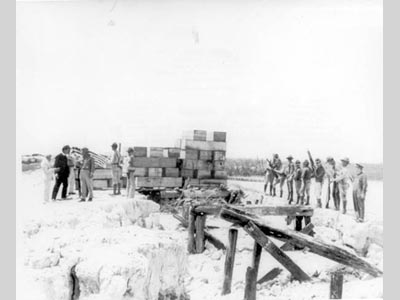The strongest tropical cyclone of the 1935 Atlantic hurricane season, which would prove to be the third most intense Atlantic hurricane on record, had very modest beginnings. It formed from a slow-moving, weak disturbance east of the Bahamas on or around August 28, 1935. On 31 August, the U.S. Weather Bureau issued its first storm advisory . The report indicated that a tropical system of small size but noteworthy strength existed about 95 km (60 mi) east of Long Island, Bahamas. The depression encountered the Great Bahama Bank later that day where warm, shallow waters combined with the storm’s slow movement, allowed it to intensify quickly. Early on 1 September, the depression reached hurricane status and continued to strengthen as it made its way through the warm waters of the Gulf Stream.
On September 2, 1935, Labor Day, the hurricane reached a peak intensity of 892 mb. The hurricane made landfall later that night as a Category 5 storm, crossing the Florida Keys between Key West and Miami, FL. As it made landfall, the hurricane delivered maximum sustained winds of approximately 298 km/h (185 mph). After passing the Keys, the hurricane slowly recurved northward and closely paralleled Florida’s west coast. The then weakened hurricane made a second landfall as a Category 2 storm near Cedar Key, FL on the afternoon of 4 September. The hurricane quickly weakened to a tropical storm as it moved inland across Georgia and the Carolinas on 5 September. By the morning of 6 September the center of storm passed again into the Atlantic near Norfolk, Virginia. It quickly regained hurricane strength, but then rapidly weakened as it became extratropical. Remnants of the storm continued northeast until it became non-tropical south of Greenland on 10 September. Practically all losses from the hurricane were suffered in Florida, with most occurring in the Florida Keys. A swath of destruction 64 km (40 mi) wide occurred across the Keys, from just south of Key Largo to just north of Marathon. Most manmade structures were destroyed by the hurricane’s Category 5 winds, which gusted at times to over 322 km/h (200 mph), and the complete inundation of the islands by a 4.6-6 m (15-20 ft) storm surge. On Metacumbe Key, every single building and tree was destroyed. The tracks of the Florida East Coast Railroad, the main transportation route linking the Keys to mainland Florida, were shifted off their roadbed and completely destroyed. The tracks were never rebuilt, as the railway now terminates in Miami. Fast Facts:
Sources: Emanuel, Kerry A. Divine Wind. New York: Oxford University Press, 2005. Pp. 136-144. McDonald, W. F., 1935: The hurricane of August 31 to September 6, 1935. Monthly Weather Review. 63: 269-271. Knowles, T.N. Category 5: The 1935 Labor Day Hurricane. Gainesville: University Press of Florida, 2009. 1935 Labor Day Hurricane. Wikipedia. 2009. Web. Scott, Phil. Hemingway’s Hurricane. New York: McGraw-Hill, 2006. |


